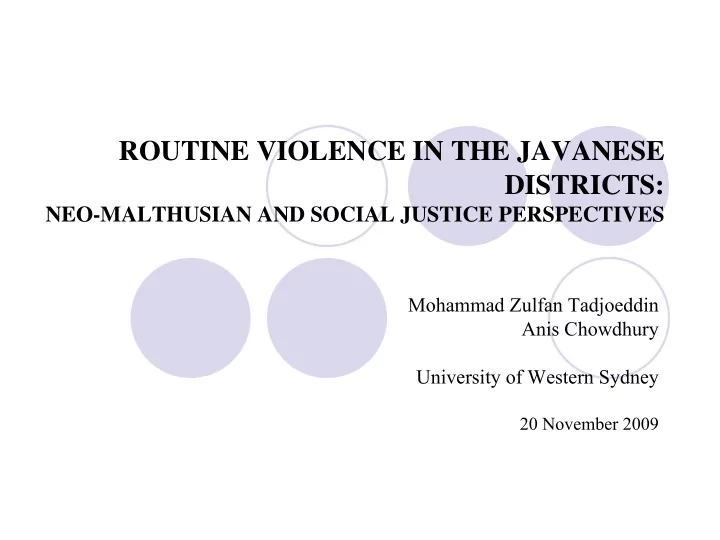

ROUTINE VIOLENCE IN THE JAVANESE DISTRICTS: NEO-MALTHUSIAN AND SOCIAL JUSTICE PERSPECTIVES Mohammad Zulfan Tadjoeddin Anis Chowdhury University of Western Sydney 20 November 2009
The context Routine and episodic violence: Low profile routine Java High profile episodic (secessionist & ethnic) off Java Java island Densely populated 128 million people The most populous island on earth 20% youth (15-25 year old) Ethnically homogeneous 85% share of two dominant ethnic groups (Javanese and Sundanese) Higher homogeneity at district level. Ethnic Javanese accounts for more than 95% in more than two-third of districts in the provinces of Central and East Java.
Indonesia and Java
The focus The two characteristics of Java lead us to the following two explanatory factors of routine violence: Population pressure Vertical inequality
(1) Population pressure Neo-Malthusian conflict scenario Social stress due to population pressure population density and growth youth bulges Marginal support at cross-country empirical study More support at cross-sectional observation in a single country, as this study show
(2) Vertical inequality Inequality and conflict in cross-country study on civil war The role of vertical inequality in conflict is rejected by Collier-Hoeffler (1998, 2004) and Fearon-Laitin (2003) At best, the role is inconclusive It is not vertical inequality that matters, it is horizontal inequality (Frances Stewart, 2000, 2008) This study finds vertical inequality does matter On low profile routine violence In a single country study
The Objective To examine the role of population/ demographic factors and vertical inequality, and their possible joint effects on routine violence across Javanese districts.
Hypotheses H1: Districts that experience higher population pressures tend to experience higher level of routine violence incidence. H2: Positive joint effects among population pressure indicators. H3: Vertical income inequality would have a positive effect on routine violence. H4: Positive effects of vertical inequality are higher in a district (region) with higher degrees of population pressure.
Research design Panel dataset of 98 districts, 1994-2003. Fixed effects negative binomial. Models: Violence = (population pressure, controls) Violence = (inequality, controls) 2-stage process = (income, income 2 ) Kuznets hypothesis • Inequality Violence = (pop. pressure*inequality, controls)
Results (1) Support for the neo-Malthusian conflict scenario with regard to population density variable only (H1) Significant join effect of population density and growth (H2).
Results (2) Positive effect of inequality on routine violence (H3), through the workability of the Kuznets curve (two-stage process). The violence inducing effect of inequality helps to explain the Tadjoeddin and Murshed’s (2007) finding on the inverted-U-shaped relationship between violence and income. Inequality effects work at the upswing as well as at the downswing parts of the inverted-U- shaped curve of violence and income
Violence, Gini &Income Gini Violence Violence 0.3 IDR 13 mil IDR 11 mil Income Income Gini A: Kuznets (1955) B: Tadjoeddin & Murshed (2007) C: This study
Result (3) Support for H4, positive joint effect between inequality and population density. This means that violence inducing risk of higher inequality is aggravated if it coincides with higher population density.
Conclusion Neo-Malthusian conflict scenario in the densely populated Java. Role of vertical inequality in routine violence. The inherent Kuznets process by which inequality aggravates violence. Unsafe mix of population pressure and inequality.
Population pressure and violence 1 2 3 4 5 6 7 Pop density (000/km2) 0.069 ** 0.087 ** 0.087 0.031 0.081 ** 0.032 0.038 0.142 0.042 0.038 Youth bulges (15-25) 0.015 -0.013 -0.013 0.002 0.002 0.023 0.026 0.033 0.026 0.032 Pop growth (%) 0.032 0.076 0.076 -0.076 0.323 0.052 0.060 0.061 0.079 0.317 Density*Youth 0.000 0.006 Pop Density*Growth 0.052 *** 0.015 Youth*Pop growth -0.010 0.013 Pop (mil) 0.357 *** 0.379 *** 0.387 *** 0.353 *** 0.353 *** 0.334 *** 0.337 *** 0.108 0.107 0.106 0.109 0.109 *** 0.110 0.110 Growth -0.034 *** -0.035 *** -0.034 *** -0.032 *** -0.032 -0.034 *** -0.032 *** 0.005 0.005 0.005 0.005 0.005 0.005 0.005 Income (IDR million) 0.191 * 0.247 *** 0.247 ** 0.154 0.154 0.198 * 0.158 0.108 0.106 0.105 0.110 0.111 0.112 0.111 Income2 -0.015 -0.016 -0.016 -0.013 -0.013 -0.014 -0.013 0.011 0.011 0.011 0.010 0.010 0.010 0.010 Obs 980 980 980 980 980 980 980 Wald χ 2 (p-value) 0.000 0.000 0.000 0.000 0.000 0.000 0.000
Two-stage regression Second stage - Fixed effects NB Violence Gini-predicted value 24.266 ** 9.681 Growth -0.035 *** 0.005 Pop (mil) 0.388 *** 0.106 Obs 980 Wald χ 2 (p-value) 0.000 First stage - pooled OLS Gini Income 0.0094 *** 0.0013 Income-squared -0.0004 *** 0.0001 Obs 980 R-squared 0.054
2SLS as a robustness check Violence gini 46.4997 *** 13.7545 grgdp -0.0752 *** 0.0149 popm 1.8642 *** 0.1390 Gini Income 0.0013 *** 7.5300 Income-squared -0.0004 *** 0.0001 Obs. 980
Join effects of Gini*population pressure 1 2 3 Gini-predicted value 22.937 ** 16.1926 21.728 ** 9.957 10.5498 10.545 Growth -0.034 *** -0.0337 *** -0.035 *** 0.005 0.0048 0.005 Pop (mil) 0.390 *** 0.3587 *** 0.381 *** 0.106 0.1078 0.107 Ginihat*popgrowth 0.095 0.175 Ginihat*popden 0.0002 ** 0.0001 Ginihat*youth 0.051 0.081 Obs 980 980 980 Wald χ 2 (p-value) 0.000 0.000 0.000
Recommend
More recommend